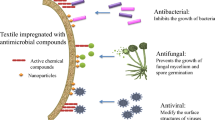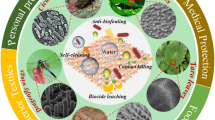Abstract
Recent interest in the treatment of textiles for chemical and biological agent defense has led to the creation of materials that contain N-chloramide moieties. These materials have demonstrated efficacy against weaponizable bacteria, mustard, and VX, as well as possessing antimicrobial properties against nuisance organisms that cause conditions such as athlete’s foot or molds. Here, N-chloramides have been attached to Nomex® intended for use as self-decontaminating regenerable military textiles. The materials were assayed for content of active oxidizing agent, and tested for efficacy against 2-chloroethyl ethyl sulfide and Demeton-S, simulants for mustard and VX, respectively. The decomposition products for each reaction were identified as well as reaction pathways to form each by-product as correlated to analogous products of mustard and VX. Furthermore, the rate constant for the neutralization of each simulant on the reactive material was calculated from data collected by GC-MS and ATR-FTIR real-time studies.














Similar content being viewed by others
References
Cornwell J (2003) Hitler’s Scientists. Penguin Group (USA) Inc., New York
The Use of RH-195 for the Decontamination of HS and M-1, AD222734, Naval Research Lab, Washington DC (1942), unclassified
Reaction between Demustardizing Agent RH-195 and L, ADB966281, Chemical Corps Technical Command Army Chemical Center (1945), unclassified
Shih ML, Korte WD, Smith JR, Szafraniec LL (1999) J Appl Toxicol 19:S89–S95
Worley SD, Sun Y (1996) Trends Polym Sci 4:364
Akdag A, Liang J, Worley SD (2007) Phosphorus Sulfur Silicon Relat Elem 182:1525–1533
Braue EH (1999) J Appl Toxicol 19:S47–S53
Sun Y, Sun G (2004) Ind Eng Chem Res 43:5015–5020
Luo J, Sun Y (2008) Ind Eng Chem Res 47:5291–5297
Qian L, Sun G (2003) J Appl Polym Sci 89:2418–2425
Qian L, Sun G (2004) J Appl Polym Sci 91:2588–2593
Chen Y, Worley SD, Huang TS, Weese J, Kim J, Wei C-I, Williams JF (2004) J Appl Polym Sci 92:368–372
Pechura CM, Rall DP (eds) (1993) Health effects of sulfur mustard and Lewisite, Veterans at risk, Chap 5. National Academy Press, Washington, DC, pp 71–80
Voronstov AV, Lion C, Savinov EN, Smirniotis PG (2003) J Catal 220:414–423
Martyanov IN, Klabunde KJ (2003) Environ Sci Technol 37:3448–3453
Ringenbach CR, Livingston SR, Kumar DR, Landry CC (2005) Chem Mater 17:5580
Yang Y, Baker JA, Ward JR (1992) Chem Rev 92:1729–1743
Yang Y (1999) Acc Chem Res 32:109–115
Yang Y, Szafraniec LL, Beaudry WT, Rohrbaugh DK (1990) J Am Chem Soc 112:6621–6627
The Hague Council, Demeton: health-based reassessment of administrative occupational exposure limits, Committee on Updating of Occupational Exposure Limits, a committee of the Health Council of the Netherlands, September 2003
Munro NB, Talmage SS, Griffin GD, Waters LC, Watson AP, King JF, Hauschild V (1999) Environ Health Perspect 107(12):933–974
Army Field Manual No. 3–9, Navy Publication No. P-467, Air Force Manual No. 355–7. Potential Military Chemical/Biological Agents and Compounds; Headquarters, Department of the Army; Department of the Navy; Department of the Air Force: Washington, DC, 12 December 1975; Appendix B
Acknowledgements
The authors would like to thank Bob Nichols for his design and construction of the permeation test cell, Patrick Sullivan for his assistance in developing the temperature and RH control system, Brenton Stone for development of LabVIEW® control software, Joe Wander for technical advice, Warwick Mills for providing Nomex® textiles, the Army Natick Soldier RD&E Center, and the Defense Threat Reduction Agency (DTRA) for funding this project.
Author information
Authors and Affiliations
Corresponding authors
Rights and permissions
About this article
Cite this article
Salter, B., Owens, J., Hayn, R. et al. N-chloramide modified Nomex® as a regenerable self-decontaminating material for protection against chemical warfare agents. J Mater Sci 44, 2069–2078 (2009). https://doi.org/10.1007/s10853-008-3114-z
Received:
Accepted:
Published:
Issue Date:
DOI: https://doi.org/10.1007/s10853-008-3114-z




